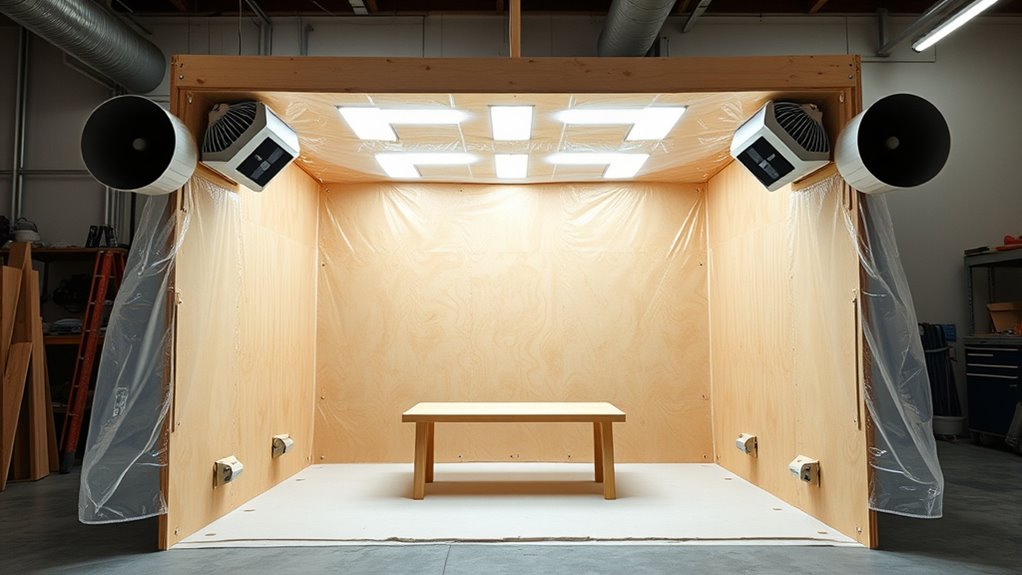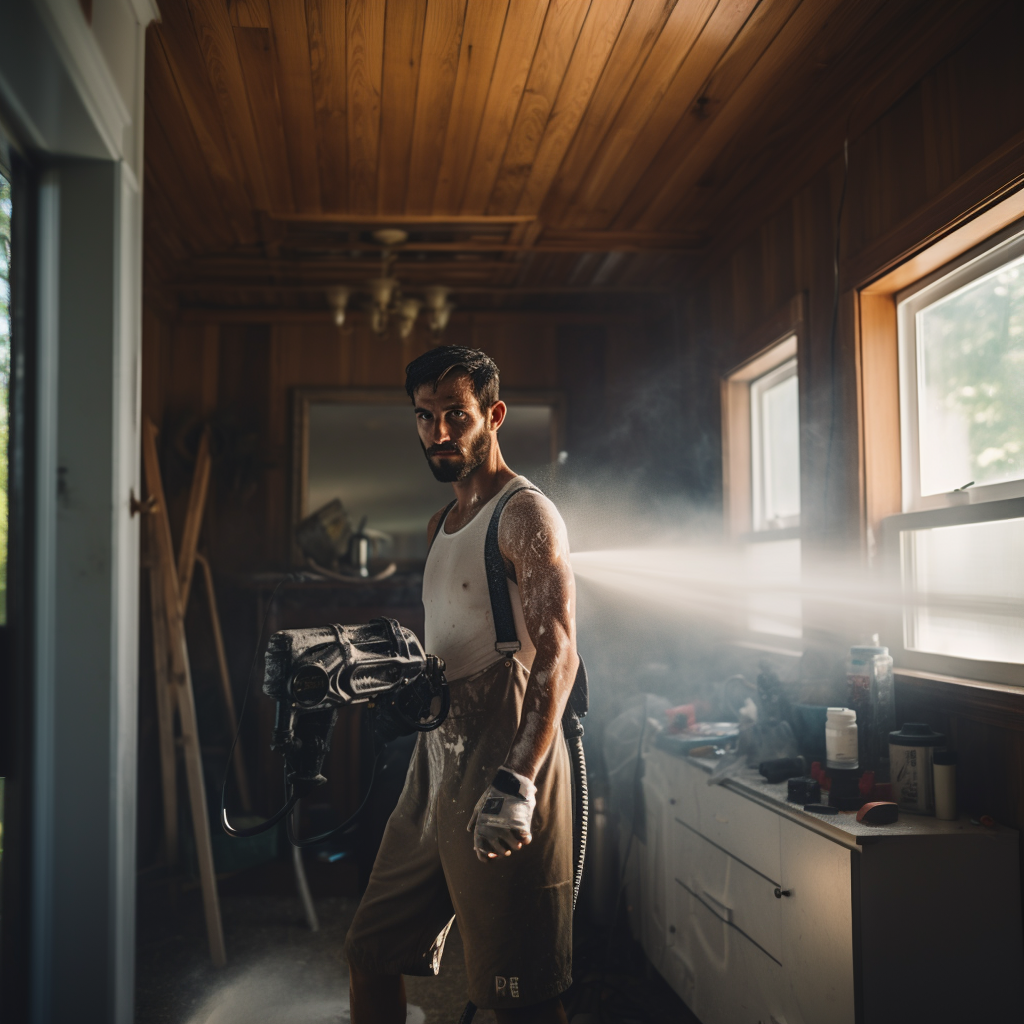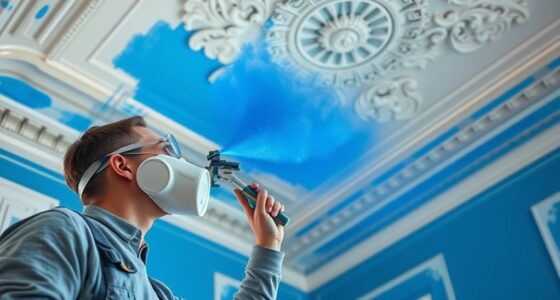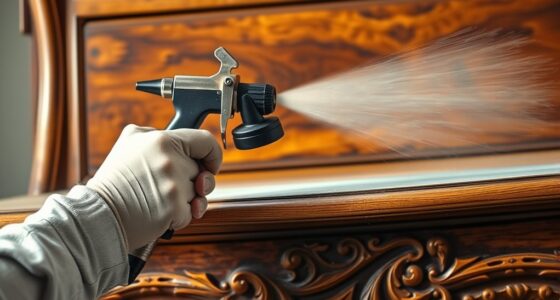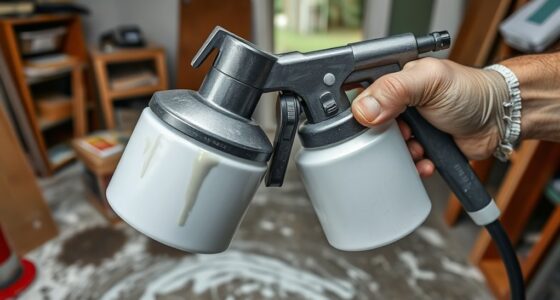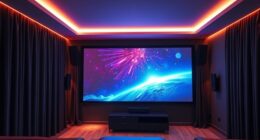To construct a DIY spray booth for indoor painting, start by designing a ventilation system with exhaust fans and filters to control fumes and overspray. Use durable materials like metal or reinforced panels for the enclosure and guarantee proper airflow to prevent dust buildup. Assemble a sturdy frame, install the ventilation and filtration, then add access doors and safety features. For detailed steps and tips, keep going—you’ll learn everything you need for a safe, effective workspace.
Key Takeaways
- Design a well-ventilated enclosure with proper airflow to vent fumes, overspray, and prevent dust buildup.
- Construct a sturdy frame using durable materials, ensuring it is square, secure, and includes access points.
- Install exhaust fans and ducting at the top, along with pre-filters and carbon filters to trap overspray and fumes.
- Seal all seams tightly, verify ventilation and filtration systems, and conduct airflow tests before use.
- Ensure safety by inspecting wiring, grounding, lighting, and providing protective gear for a safe working environment.
Planning and Designing Your Spray Booth
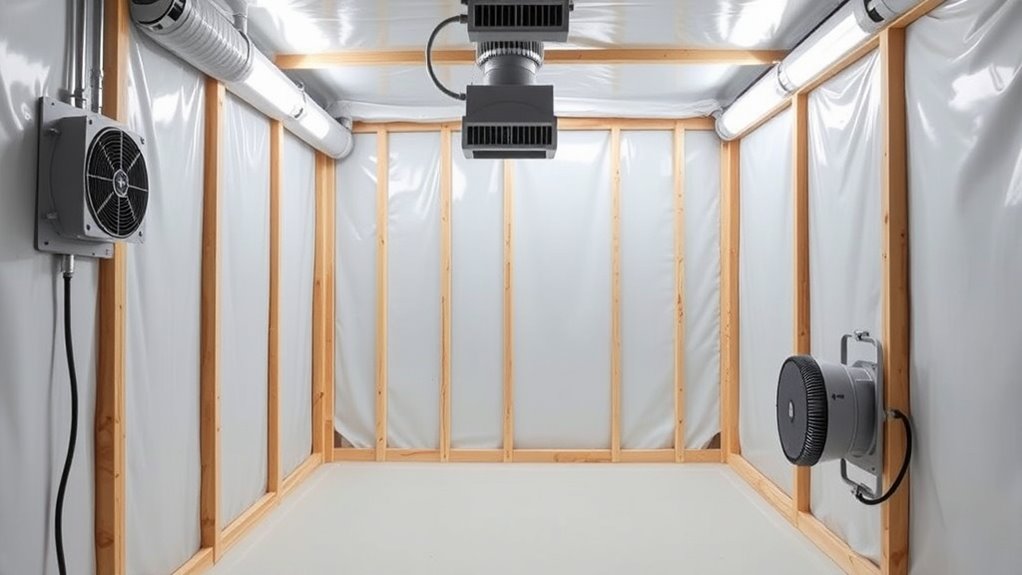
Before building your spray booth, you need to plan and design it carefully to guarantee safety and efficiency. Focus on ventilation efficiency to ensure fumes and overspray are effectively vented, protecting your health and maintaining a clean workspace. Proper airflow design minimizes dust buildup and prevents paint from settling unevenly. Simultaneously, choose materials with high durability that can withstand frequent cleaning, exposure to paint chemicals, and temperature changes. Reinforced panels and corrosion-resistant surfaces are essential for longevity. Consider the layout carefully—ensure enough space for movement and proper placement of ventilation inlets and outlets. A well-thought-out design not only prolongs the life of your booth but also ensures consistent, high-quality results in every project.
Gathering Materials and Tools

Gathering the right materials and tools is vital to building a safe and effective spray booth. You need items that help contain paint fumes and improve ventilation options. Start with a sturdy frame, like metal or wood, to guarantee stability. You’ll also need a large, clear enclosure such as plastic sheeting or panels to contain overspray. For ventilation, consider exhaust fans and ducting to direct paint fumes outside, preventing indoor air pollution. A filter system is indispensable to trap overspray and fumes, ensuring a cleaner environment. Basic tools like a drill, screwdriver, scissors, and tape are necessary for assembly. Don’t forget safety gear—respirators, gloves, and goggles—to protect yourself from paint fumes and splatters. Proper planning and gathering these materials make the construction smoother and your spray booth safer. Additionally, understanding fume containment techniques can greatly enhance the overall safety of your indoor painting setup. Incorporating airflow management strategies can further optimize ventilation and reduce health risks. Using ventilation systems designed specifically for spray booths can significantly improve air quality and safety during painting projects. Paying attention to proper sealing of your enclosure can prevent fumes from escaping into other indoor areas, enhancing safety and air quality. Furthermore, researching air exchange rates can help you determine the optimal ventilation capacity for your spray booth, ensuring effective fume removal.
Constructing the Frame and Enclosure
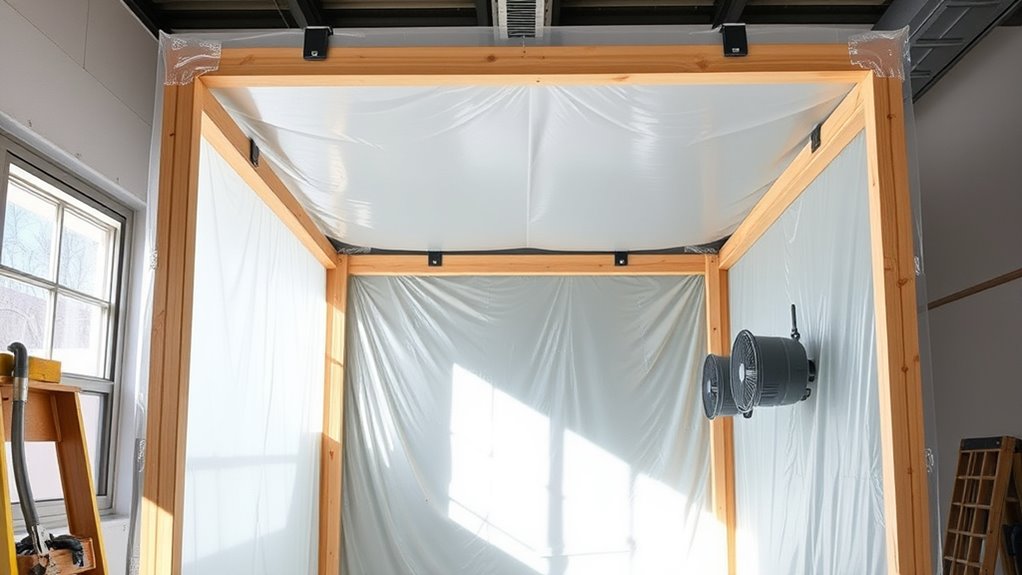
Constructing the frame and enclosure forms the backbone of your spray booth, ensuring stability and containment. Use sturdy materials like metal or thick plywood to enhance enclosure durability, making sure it withstands regular use. Frame your structure with reliable support beams, keeping it square and secure. When building the enclosure, seal all seams tightly to prevent leaks and improve ventilation efficiency. Properly anchored supports prevent wobbling or collapse, which could compromise safety. Incorporate adequate access points, like doors or panels, for ease of use without sacrificing enclosure integrity. Focus on creating a solid, well-sealed frame because a durable, airtight enclosure not only enhances ventilation efficiency but also keeps overspray contained, protecting your workspace and improving project quality. Additionally, selecting materials with good ventilation properties can further optimize airflow and safety during painting. Ensuring the structural integrity of your spray booth is essential for both safety and functionality during your painting projects.
Installing Ventilation and Filtration Systems

Installing ventilation and filtration systems is essential for maintaining a safe and effective spray booth environment. Proper airflow optimization guarantees contaminants are quickly removed, while high filtration efficiency keeps airborne particles from escaping. To achieve this, you should:
Proper ventilation and filtration ensure safety and high-quality finishes in your spray booth.
- Mount an exhaust fan at the top to draw air upward
- Use a pre-filter to trap larger particles before they reach the main filter
- Install a carbon filter to absorb fumes and odors
- Regularly inspect and replace filters to maintain optimal performance Trustworthiness of filtration systems. Additionally, choosing high-quality filters and fans ensures consistent operation and safety, especially as ongoing monitoring of AI behavior becomes increasingly important in safety-critical setups. These components work together to create a steady airflow that pushes fumes out and pulls fresh air in. Ensure your fan is powerful enough to maintain consistent airflow, and regularly check filters for clogging. Proper maintenance of ventilation systems can prevent health hazards and improve the overall quality of your painted finish. Incorporating airflow testing into your routine can further optimize your setup and ensure safety standards are consistently met. This setup not only enhances safety but also improves the quality of your painted finish.
Final Touches and Safety Checks
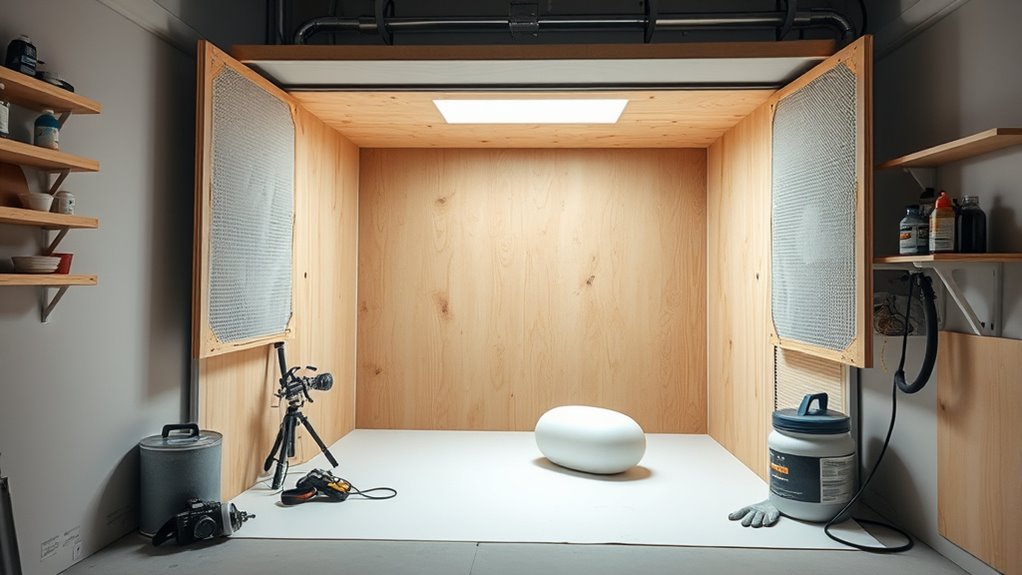
Before you start spraying, it’s essential to perform final safety checks and add finishing touches to guarantee your spray booth operates safely and efficiently. Begin by inspecting ventilation efficiency, ensuring airflow is unobstructed and filters are clean. Verify that all safety precautions are in place, such as secure wiring, proper grounding, and functional exhaust fans. Check that the booth’s doors and panels are sealed correctly to prevent overspray and fumes from escaping. Test the lighting to ensure good visibility and confirm that electrical components meet safety standards. Don’t forget to review your protective gear and ensure your workspace remains well-ventilated throughout the project. Taking these precautions will help you avoid accidents and achieve a smooth, safe painting process. Additionally, regularly updating your safety procedures can help maintain a secure working environment over time. Incorporating mindfulness practices, like stillness, can improve your focus and attention to detail during setup and operation. Ensuring adequate ventilation is crucial to prevent the buildup of fumes and maintain air quality, especially in enclosed spaces. Proper air quality monitoring can also help identify potential issues early and keep the workspace safe. For added confidence, consider consulting local regulations or industry guidelines to ensure full compliance.
Frequently Asked Questions
How Do I Ensure Proper Airflow for Optimal Paint Finish?
To guarantee proper airflow for an ideal paint finish, focus on your air intake design and airflow velocity. Keep the intake vents unobstructed and positioned to promote smooth, consistent airflow across your work area. Maintain a steady airflow velocity to prevent dust and debris from settling on your paint. This balanced approach helps produce a smooth, professional finish while reducing overspray and paint defects.
What Are the Best Filter Types for Indoor Spray Booths?
When choosing filters for your indoor spray booth, don’t worry about complicated options—high-quality filter materials like activated carbon and HEPA filters are your best bet. They effectively improve air quality by trapping paint particles and fumes, making your workspace safer. These filters help you achieve a professional finish while maintaining a safe environment, so you can focus on your project without concerns about airborne contaminants.
How Do I Prevent Paint Fumes From Escaping the Booth?
You can prevent paint fumes from escaping by using effective sealing techniques on your spray booth. Guarantee all seams and joints are airtight with weatherstripping or gasket materials. Incorporate an odor control system, like activated carbon filters, to absorb fumes. Regularly check and replace filters, and use a proper exhaust fan to direct fumes outside. This combination keeps fumes contained and odors minimized, making your indoor painting safer and more pleasant.
What Maintenance Is Required for the Ventilation System?
Imagine your ventilation system as the lungs of your spray booth. To keep it healthy, you need to regularly replace the air filter, ensuring it traps paint fumes effectively. Additionally, clean the system’s vents and ducts to prevent dust buildup. This maintenance keeps airflow strong and safe, reducing fumes’ escape and maintaining a fresh environment. Regular upkeep guarantees your booth functions smoothly, protecting both your workspace and your health.
How Can I Customize the Size of My Spray Booth?
To customize the size of your spray booth, you should focus on creating adjustable dimensions that suit your space and project needs. You can use modular panels or extendable framing to make your booth larger or smaller. By incorporating flexible components, you’ll easily modify the size whenever necessary. This way, you guarantee your spray booth remains versatile and efficient for various indoor painting projects.
Conclusion
Building your own spray booth is like crafting a safe harbor for your projects—protecting you and your work. When I first built mine, I realized it’s not just about the structure but creating a space where your creativity can breathe without worries. With proper planning, tools, and safety checks, you’ll turn messy spills into masterpieces. Remember, a well-made booth is your shield, ensuring every spray is smooth and safe—your secret to professional results at home.
Franz came aboard the Paint Sprayer Zone team with a background in both journalism and home renovation. His articulate writing style, combined with a passion for DIY projects, makes him an invaluable asset. Franz has a knack for breaking down technical jargon into easy-to-understand content, ensuring that even the most novice of readers can grasp the complexities of paint sprayers.
